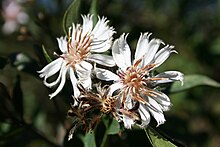
The family Asteraceae, with the original name Compositae, consists of over 32,000 known species of flowering plants in over 1,900 genera within the order Asterales. Commonly referred to as the aster, daisy, composite, or sunflower family, Compositae were first described in the year 1740. The number of species in Asteraceae is rivaled only by the Orchidaceae, and which is the larger family is unclear as the quantity of extant species in each family is unknown.

Ionactis, common name stiff-leaved asters or ankle-asters, is a small genus of plants belonging to the family Asteraceae. These aster-like plants are endemic to North America. One species is widespread across much of the eastern half of the continent, while two others are rare endemics with very restricted ranges.

Symphyotrichum is a genus of over 100 species and naturally occurring hybrids of herbaceous annual and perennial plants in the composite family, Asteraceae, most which were formerly treated within the genus Aster. The majority are endemic to North America, but several also occur in the West Indies, Central and South America, as well as one species in eastern Eurasia. Several species have been introduced to Europe as garden specimens, most notably New England aster and New York aster.

Calocephalus is a genus of flowering plants in the family Asteraceae. It is endemic to Australia, where it is represented in every state.
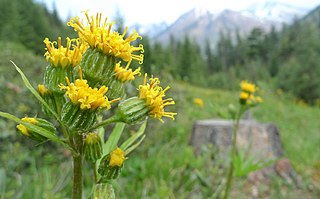
Cacaliopsis is a monotypic genus of flowering plants in the aster family, Asteraceae, containing the single species Cacaliopsis nardosmia. It is known by the common name silvercrown. It is native to western North America.
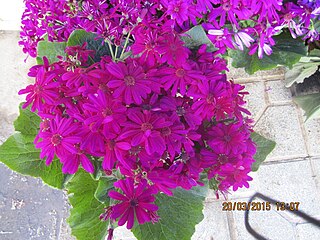
Cineraria deltoidea is a perennial flowering plant of the family Asteraceae and the genus Cineraria which is also the closest known relative of the giant Dendrosenecio of East Africa.

Liabeae is a tribe in the plant family Asteraceae. It is endemic to the Neotropics, where it is most diverse in the northern and central Andes. The center of diversity is in Peru.

Ageratina herbacea is a North American species of flowering plants in the family Asteraceae known by the common names fragrant snakeroot and Apache snakeroot. It is native to desert regions of the southwestern United States and northern Mexico. It grows in rocky slopes in conifer forests and woodlands.
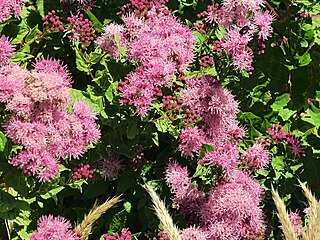
Ageratina occidentalis is a species of flowering plant in the family Asteraceae known by the common name western snakeroot or western eupatorium. It is native to the western United States where it grows in several types of habitat. It is found in California, Oregon, Washington, Idaho, Montana, Nevada, and Utah.
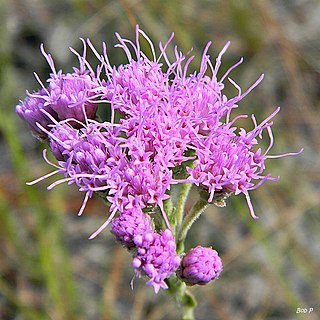
Carphephorus is a genus of North American plants in the family Asteraceae. They are native to the southeastern United States from Louisiana to Virginia. Plants of this genus are known commonly as chaffheads.

Carphochaete is a genus of North American flowering plants in the family Asteraceae. They are native to Mexico and the southwestern United States. They are known commonly as bristleheads.
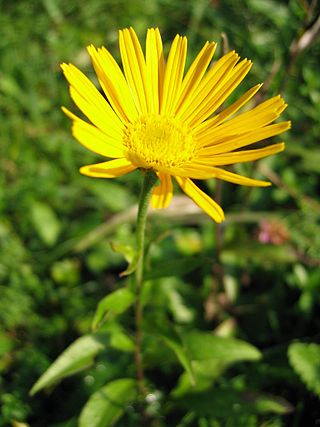
Buphthalmum is a genus of flowering plants in the aster family, Asteraceae. There are 2 or 3 species. They are native to Europe, and B. salicifolium is in cultivation and has been introduced elsewhere.

Stenotus is a genus of flowering plants in the family Asteraceae. There are four species, all native to western North America. They are known commonly as mock goldenweeds.
Jensia yosemitana is a species of flowering plant in the family Asteraceae known by the common name Yosemite tarweed. It is endemic to California, where it has a scattered distribution across the Sierra Nevada and its foothills. Some of the populations lie inside Yosemite National Park.

Didelta is a genus of shrubs of up to 1 or 2 meter high, with two known species in the daisy family. Like in almost all Asteraceae, the individual flowers are 5-merous, small and clustered in typical heads, and are surrounded by an involucre, consisting of in this case two whorls of bracts, which are almost free from each other. The 3–5 outer bracts are protruding and triangular in shape, the inner about twice as many are lance-shaped and ascending. In Didelta, the centre of the head is taken by 3–5 clusters of bisexual yolk yellow disc florets, sometimes divided from each other by male disc florets, and is surrounded by one complete whorl of infertile yolk yellow ray florets. The common base of the flowerhead swells around the developing fruitlets, become woody and breaks into segments when ripe. The fruitlets germinate within this woody encasing. The species of the genus Didelta can be found in Namibia and South Africa. The genus is called salad thistle in English and slaaibos in Afrikaans.

Gochnatia is a genus of flowering plants in the daisy family, Asteraceae. It is named for botanist Frédéric Karl Gochnat. The genus contains mainly shrubs and subshrubs, with a few trees and herbs. All of the species are native to the American tropics. Two species native to the mountains of Southeast Asia and formerly included here are now separated as the genus Leucomeris in subfamily Wunderlichioideae.
Calostephane is a genus of flowering plants in the aster family, Asteraceae.
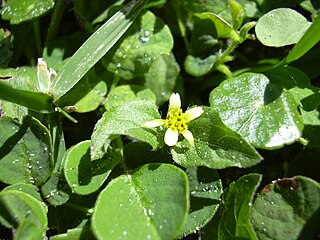
Calyptocarpus is a genus of flowering plants in the family Asteraceae.
Chiliotrichiopsis is a genus of flowering plants in the family Asteraceae. It is native to the Andes, where it is distributed in Peru, Bolivia, and Argentina. Species occur in the mountains up to 4200 meters in elevation.
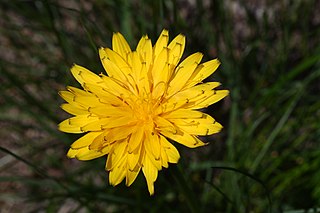
Nothocalais alpestris is a species of flowering plant in the family Asteraceae known by the common name alpine lake false dandelion. It is native to the Cascade Range, Sierra Nevada and other mountains from northern Washington to central California, where it grows in subalpine forests and meadows, most commonly at 1,200–2,700 m (4,000–9,000 ft) elevation.
